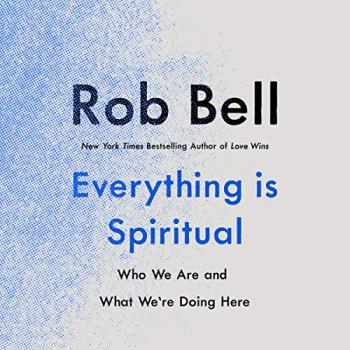“When we choose to re-enter into relationship with the spirits, we shift our perceptions of what is real or possible and so can more easily manifest creative solutions to our current issues. In expanding our awareness, we change the landscape of possibilities that are open to us.” — Evelyn C. Rysdyk, author and shamanic teacher
This month at the Patheos Book Club, we’re featuring a new book by artist and shamanic teacher Evelyn C. Rysdyk called A Spirit Walker’s Guide to Shamanic Tools: How to Make and Use Drums, Masks, Rattles, and Other Sacred Implements. Here, Rysdyk answers a few questions about her book and shamanic spirituality.
Why did you feel it was important to write another book on shamanic spirituality?
When I first began studying with well-respected tribal shamans many years ago, I realized that they had “certain something” that allowed them to be a lot more effective than most Western-trained practitioners. These shamans sizzled with spiritual power, they seem a lot more grounded, were more content and had a kind of profound joyfulness about life that was contagious. This was even true of those who had experienced terrible hardship.
I soon realized that the difference was about connection. It wasn’t just being able to journey and meet with spirits that made a shaman powerful. It wasn’t that they exclusively journeyed to the Upper World or the Lower World or the Middle World. These people were in deep relationship with the spirits, with the land, with other living beings and with themselves.
You write about the concept of Reverent Participatory Relationship. Would you explain this idea?
I use the phrase, Reverent Participatory Relationship as the way to describe the intentional, caring and honorific way shamans approach the world. It is a full-hearted and whole body way of being in connection.
The shaman’s role in society is to act as a facilitator between the human realm and that of the other spirits that inhabit the environment. Through interaction with these spirits, shamans understand that the intrinsic interdependencies among them all, is what sustains life.
 Shamans borrow power to assist in facilitating harmony within the environment, within the community and within the body of an ill person. They may work with the spirits of animals, from natural landscape features and from the elementals and in all cases, these are spirits with whom the shaman has developed a relationship that is respectful, reciprocal and often long-standing.
Shamans borrow power to assist in facilitating harmony within the environment, within the community and within the body of an ill person. They may work with the spirits of animals, from natural landscape features and from the elementals and in all cases, these are spirits with whom the shaman has developed a relationship that is respectful, reciprocal and often long-standing.
Western people tend to be less connected to the spirits, perhaps because we are so cerebral. While shamanic journeying produces a sense of connectedness, yet for many people spirituality can still remain a mostly mental experience.
Why do you think being in relationship with the natural world and other species is so important?
The natural world is the root of everything. In our arrogance we humans have forgotten that we are inexorably tied to the natural world. Yet, we are a part of its fabric. We cannot live without it.
It is critical for our own health and the health of all species that we reconnect our minds, hearts, and bodies with nature again. This is difficult when we have distanced ourselves from it. When we learn to communicate with the sentience that surrounds us in the trees, animals, birds, plants, stones and waterways we begin the process of reunion. A deeper understanding for our intricately interconnected family begins to grow we are more likely to nurture these relationships. As we continue our communication we develop stronger heart connections with the beings with whom we share the world. And as the Senegalese conservationist Baba Dioum has said, “In the end we will conserve only what we love…”
If shamanism is a prehistoric worldview, how can it be relevant in today’s world?
Shamanism is a proven practice. For tens of thousands of years our ancestors had to be in deep connection with the environment. Our hunter-gatherer forebears needed to understand the weather, to track the movements of game, to know when plants could be gathered, or when the fish were running as well as being able to perceive the subtleties of seasonal shifts. Knowing these things was critical for their survival. Shamanism provided a way to communicate with all the aspects of nature so that our species could thrive.
A study in 2000 looked at the health and wellbeing of two tribes living in the same area of the Western Congo Basin. One tribe, the Ngandu, were subsistence farmers and their neighbors, the Aka still practiced hunting and gathering. The people of the Aka were more psychologically and emotionally secure as they retained deep relationships with the environment and each other. In being in intimate relationship with all the species around them who provided food, water and shelter, the Aka were much more joyful, secure and well-adjusted than their neighbors.
Today, people want to feel less anxiety, to feel less depression and replace those feelings with a deep sense of feeling more connected, powerful and whole! Through over twenty years of working with clients in my shamanic healing practice, I found that when folks re-enter into intentional relationships with the animals, plants and other people, they feel profoundly supported by the world around them. As a result, they become more effective and more productive in their lives.
Shamanic spirituality is a way for individuals to feel more at home in their bodies, in their communities and in the world.
How have your experiences with tribal shamans and shamanic journeying helped to create your viewpoint?
Tribal shamans are actively engaged in relationship with the spirits of the natural world as well as their tutelary spirits and protectors. They are constantly reinforcing the bridges of connection through communication, honoring rituals, making offerings and celebration. There is an understanding that it is through these relationships that health and wellbeing are maintained—not only for the shaman but for all of the beings surrounding them.
Explain why you have included meditations and exercises in the book.
In order to enter into relationship with nature, the spirits a person needs to reconnect to the heart of who they are.
How will the practices you describe really help the modern person?
According to anthropologists such as Michael Winkelman and Mike Williams, altered consciousness experiences and relationships with transcendent spirits have contributed to our species’ cognitive evolution.
Expanding minds and spirits into transcendent realms helped to open up new pathways of human thought and ability. This kind of shamanic evolution is made possible because all human beings are capable of multidimensional experience. Using our imagination as a springboard, we have the potential to reach solutions that lie beyond our perceptual limitations.
In the book, The Universe as a Hologram the author, Michael Talbot argues that we agree on what is “real” or “not real” because we have believed our senses and have created a consensus reality, which has been formulated and ratified at the level of the collective human unconscious at which all minds are infinitely interconnected.
When we choose to re-enter into relationship with the spirits, we shift our perceptions of what is real or possible and so can more easily manifest creative solutions to our current issues. In expanding our awareness, we change the landscape of possibilities that are open to us.
How has your background led you to write on the subject of shamanism?
My own difficult situation led me to explore the ways of the shaman. In my earlier life, I experienced a profound depression. The light and joy drained from my life. While I worked with a counselor and took medication to allow me to sleep, neither these nor my strength of will was enough to lift me out of the darkness. Being deeply depressed is like being a horse wearing blinders. Your world narrows to a sliver of its former richness. You lose all ability to perceive the full depth and breadth of life.
While searching for ways to recover my confidence and vitality, I found an advertisement for a workshop with anthropologist Michael Harner about the Way of the Shaman. After a half day of his delightful stories, Michael led me into my first shamanic journey experience. As soon as I entered the world of the spirits, something astonishing occurred. I had the extraordinary feeling of possibilities rushing back to me. They weren’t specific notions, just the sense that opportunities, ideas, and desires were suddenly feasible again. That moment set my feet on the spirit walker’s path. I read, took workshops, studied with tribal shamans, but most importantly, I entered into deep relationships with a power animal and spirit teacher. Over the next decades, I came to understand what these affiliations provided. Relationships with spirits altered my ways of interacting with other people, other beings, and my environment. I was changed and discovered that these connections were the true source of power.
Are there support materials available for people who want to go deeper with the information presented in this book?
I have made support materials available through the Spirit Walking area of my website, www.evelynrysdyk.com. There people can find audios of all the meditations in my book, Spirit Walking as well as patterns for the projects in A Spirit Walker’s Guide to Shamanic Tools.
Do you offer workshops or trainings about this approach?
Absolutely. While a book can begin to open up this world it is vitally important to study with a human being. Working with human teachers offers nurturance, guidance and direction along the path that is essential for the developing practitioner. Toward that end, I offer short presentations, one and two-day workshops as well as apprenticeship programs in advanced shamanism and shamanic healing. More information may be found on the website: www.spiritpassages.com which can also be accessed through my author site: www.evelynrysdyk.com.
Visit the Patheos Book Club for more on A Spirit Walker’s Guide to Shamanic Tools!













